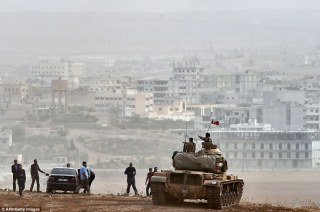It is mid-2014 and fighting is raging all across Syria and Iraq. In northern Syria, the Islamic State of Iraq and al-Sham, or ISIS (Henceforth Daesh), is on the offensive. Throughout July and August, thousands of ethnic Kurds fled north toward Turkey, many through the border town of Kobanê. Kobanê is the seat of the Kobanê canton and is a local headquarters of the Kurdish People’s Protection Units (YPG), and is thus an important strategic location to hold. Furthermore, its population of approximately 50,000 (pre-war) makes it one of the larger cities in Kurdish northern Syria, also known as Rojava. Thus, the YPG was determined not to lose the city.
 |
| Kurdish YPJ (Women’s Protection Units) soldier in front of a YPG soldier |
Advancing rapidly toward Kobanê was Daesh, high on their recent successes in Iraq (including sacking the second-largest city in the country, Mosul) and bloated with military equipment (most of which was captured near Mosul). Also Captagon. They were also high on that. In any case, they were equipped with some pretty hardcore weaponry, ranging from anti-aircraft artillery mounted in pickup trucks to main battle tanks and rocket artillery, along with thousands of American HMMWVs. The defenders in Kobanê had mere Kalashnikovs and Molotov cocktails, maybe a rocket-propelled grenade (RPG) scattered here or there.
 |
| Mark was reportedly unaware that he had aided and abetted ISIS when he traded in his truck |
 |
| Captured T-54/55 with a North Korean aftermarket laser rangefinder mounted above the barrel |
The assault on Kobanê began in early September, and by the end of the month the fighting had ground to a halt as the war went from open fields to house-to-house combat. Everywhere Daesh advanced they left infested with an array of anti-personnel traps inside houses and alleyways. Many began referring to Kobanê as the Kurdish Stalingrad, hearkening back to the famous WWII battle in which the Soviets, against overwhelming Nazi technology and training, turned back the German army and reversed the tide of the entire war in Europe.
 |
| Turkish tanks observe the battle from across the border |
On September 27th, 2014, the first coalition airstrike took place near Kobanê, with an American F-15E targeting a Daesh headquarters building and two armored vehicles. Thus began a pattern of coalition airstrikes being coordinated by YPG forces on the ground, a task now handled primarily by US and coalition special forces.
 |
| Kobanê almost halfway under Daesh control |
Despite heavy coalition air support, Daesh managed to push the YPG almost out of the city. Early in September (9/14) the YPG and elements of the Free Syrian Army had formed a joint-operations room known as Euphrates Volcano with which they could coordinate their fight against Daesh. This alliance played a key role in the battle of Kobanê, with reinforcements from the FSA and the YPG arriving via Turkey throughout the fall and early winter of 2014.
Try as they might, Daesh could not push the YPG/FSA out of the city, and by spring 2015 the battle was pushing back out of the city. Kobanê never fell, and today is the seat of the entire Kobanê canton, which stretches from the Euphrates river in the west all the way to the border with the Jazira canton in the east. However, evidence of the massive human exodus remains visible from space, and can be seen with Google Earth.
 |
| Kobanê today (2 May 2016), marked here as Ayn al-Arab |
 |
| Thousands of cars parked at the Turkish/Syrian border, abandoned by their owners in the flight northward |
Despite heavy levels of destruction, Kobanê never fell and lives on, rebuilding as I write this, with thousands moving back to the city every month. In the hell that is the Syrian civil war, we can count this one as a victory for the “good guys”.

bookmarked
LikeLike